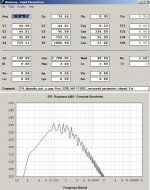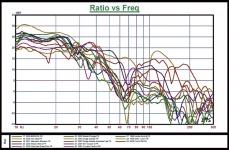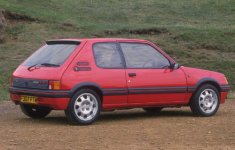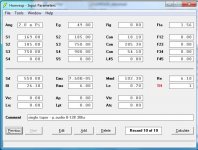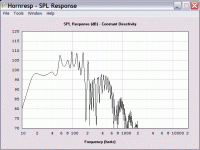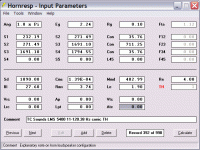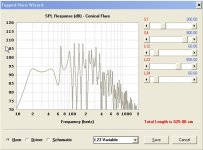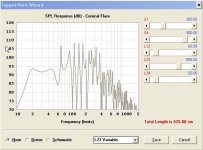sloped response TH
Post #3295
Hi just_a_guy, I'm not sure this is the right place for a tapped horn either, but, I just used your general parameters, and came up with this:
116.8dB @ 25Hz - 125.8dB @ 50Hz - 135.4dB @ 100Hz.
That's more like 10dB per octave, but below 80 liters. Try these values as a starting point, and move S3 around to change the slope.
Regards,
Post #3295
Hi just_a_guy, I'm not sure this is the right place for a tapped horn either, but, I just used your general parameters, and came up with this:
116.8dB @ 25Hz - 125.8dB @ 50Hz - 135.4dB @ 100Hz.
That's more like 10dB per octave, but below 80 liters. Try these values as a starting point, and move S3 around to change the slope.
Regards,
Attachments
That is interesting (although with 300w your model is way past xmax). Not sure why I wasn't able to come up with something like that, probably because I was limiting mouth size to 625 cm (10x10 inch mouth).
Anyway, in order to compare, I changed a couple of things around to get the same tuning, same slope, same size, etc. Black line = FLH, 325w. Grey line = TH, 250w. Both at xmax.

Given the same power, they are very similar, but hornresp says the FLH can use a bunch more power than the TH before it hits xmax. Whether the driver can handle it thermally is questionable though.
Anyway, in order to compare, I changed a couple of things around to get the same tuning, same slope, same size, etc. Black line = FLH, 325w. Grey line = TH, 250w. Both at xmax.

Given the same power, they are very similar, but hornresp says the FLH can use a bunch more power than the TH before it hits xmax. Whether the driver can handle it thermally is questionable though.
Just a couple of thoughts.
Hello Just a guy
For your car application the low end will get up to 20db boost around 20 hz from cabin gain. So if you have the length of horn to support the low end you will get it! I have used this little trick for years to great effect.
Second thought is that the best way to compare the horn response is not at the power maximums but where we will actually be using them. That is around 3 to 12 watts. If you find it hard to believe try putting a volt meter on the terminals of your horn and listen at the levels you like. Then do the math to convert the voltage to watts and find out for yourself.
In simulating hons and building them I find that the low level response of a couple of watts is the sound we end up with because we rarely ever drive them to the max.
Mark
Hello Just a guy
For your car application the low end will get up to 20db boost around 20 hz from cabin gain. So if you have the length of horn to support the low end you will get it! I have used this little trick for years to great effect.
Second thought is that the best way to compare the horn response is not at the power maximums but where we will actually be using them. That is around 3 to 12 watts. If you find it hard to believe try putting a volt meter on the terminals of your horn and listen at the levels you like. Then do the math to convert the voltage to watts and find out for yourself.
In simulating hons and building them I find that the low level response of a couple of watts is the sound we end up with because we rarely ever drive them to the max.
Mark
Interesting idea building a TH with rising response...
I'm tempted to try something similar, right now in my car I'm running an Autotuba which is a FLH, and while it sounds good and has a rising response, it's rather large and there is no more room in my boot (trunk) for anything but the speaker...
I'm tempted to see if I can achieve a similar response from a TH but in a smaller box, I need to get to grips with ARTA and maybe try it out in the car to see how the Autotuba performs first.
I'm tempted to try something similar, right now in my car I'm running an Autotuba which is a FLH, and while it sounds good and has a rising response, it's rather large and there is no more room in my boot (trunk) for anything but the speaker...
I'm tempted to see if I can achieve a similar response from a TH but in a smaller box, I need to get to grips with ARTA and maybe try it out in the car to see how the Autotuba performs first.
Great graph, thanks for posting it.  I think my car look pretty similar to a Mini Cooper as it's a hatchback, but it's smaller than the Mini. I've attached a pic, the wheels are 15" so you can see it's a small car even by euro standards!
I think my car look pretty similar to a Mini Cooper as it's a hatchback, but it's smaller than the Mini. I've attached a pic, the wheels are 15" so you can see it's a small car even by euro standards!  Am I right in assuming the smaller the cabin the more cabin gain you get?
Am I right in assuming the smaller the cabin the more cabin gain you get?
The mini looks to have a amount of gain below 50Hz tho, so maybe I could just have it so the horn is tuned for 50Hz and above which means I may be able to use quite a small box...
The mini looks to have a amount of gain below 50Hz tho, so maybe I could just have it so the horn is tuned for 50Hz and above which means I may be able to use quite a small box...
Attachments
Re: Just a couple of thoughts.
Very very true, but... I don't have any material that goes that low so there's no point. I've used a 30 hz sub in the past in a music only car system and didn't feel I was missing anything. Besides, low(er) end extension usually comes at the cost of max spl potential. IMO, in a low budget system in my crappy car, max spl potential wins.
Oh, I believe you. My home amp has led power indicator lights and my nighttime listening spl levels only require power measured in hundredths of a watt. OTOH, it will be pushed to it's limits probably on average once or twice a week (even if only for a few minutes), so comparison at xmax in this case at least is valid. The FLH I posted looks better than the TH I posted regardless of power level anyway.
Thanks for the comments.
mwmkravchenko said:Hello Just a guy
For your car application the low end will get up to 20db boost around 20 hz from cabin gain. So if you have the length of horn to support the low end you will get it! I have used this little trick for years to great effect.
Very very true, but... I don't have any material that goes that low so there's no point. I've used a 30 hz sub in the past in a music only car system and didn't feel I was missing anything. Besides, low(er) end extension usually comes at the cost of max spl potential. IMO, in a low budget system in my crappy car, max spl potential wins.
Second thought is that the best way to compare the horn response is not at the power maximums but where we will actually be using them. That is around 3 to 12 watts. If you find it hard to believe try putting a volt meter on the terminals of your horn and listen at the levels you like. Then do the math to convert the voltage to watts and find out for yourself.
In simulating hons and building them I find that the low level response of a couple of watts is the sound we end up with because we rarely ever drive them to the max.
Mark
Oh, I believe you. My home amp has led power indicator lights and my nighttime listening spl levels only require power measured in hundredths of a watt. OTOH, it will be pushed to it's limits probably on average once or twice a week (even if only for a few minutes), so comparison at xmax in this case at least is valid. The FLH I posted looks better than the TH I posted regardless of power level anyway.
Thanks for the comments.
P.Audio FL-12LF 30hz:
(Still investigating the folding/ single vs. dual taper issue)
It slightly exceeds linear xmax, but according to this http://www.diyaudio.com/forums/showthread.php?postid=1797488#post1797488 still within acceptable limits.
(Still investigating the folding/ single vs. dual taper issue)
It slightly exceeds linear xmax, but according to this http://www.diyaudio.com/forums/showthread.php?postid=1797488#post1797488 still within acceptable limits.
Attachments
fb said:P.Audio FL-12LF 30hz:
(Still investigating the folding/ single vs. dual taper issue)
It slightly exceeds linear xmax, but according to this http://www.diyaudio.com/forums/showthread.php?postid=1797488#post1797488 still within acceptable limits.
If the T-S parameters are correct it looks like the FL12LF is even better for a TH than the Faital Pro 12HP1020 that Tom currently favours (used in the TH-212 and TH-812), which would make it probably the best 12" TH driver around -- and hopefully not too expensive. Does anyone know the rough price?
But having compared the parameters to the other drivers in the FL range with the same magnet structure I'm not convinced that they're correct -- it wouldn't be the first time that P.audio have had wrong T-S parameters in their data sheets.
I don't suppose anyone has measured one to see if this is the case or not?
Ian
iand said:Does anyone know the rough price?
P.Audio offered to sell me some direct from Thailand if the Aus distributor didn't have any... but I'm a fair way off from purchasing so didn't enquire as to price.
I'm also concerned as to accuracy of T/S specs.....
Alternatively, the B&C 12TBX100 performs similarly in same cab, though is pushing the displacement/xmax issue a little harder.
Hey all. I'm a longtime lurker and this is my first post. I've been contemplating a TH build for awhile and just recently I had an encounter with Ivan B. of DSL and a THspud and more notably a TH50 that peaked my interest again. I've been playing with HR for a bit and I've read this entire thread but I'm still green at the TH's and horns in general. Hopefully I can get some pointers from the more knowledgeable people around here. I've done quite a bit of modeling using the various drivers that I have ,but I don't really know if they are suitable for a TH. I'm shooting for a big (under 900L hopefully) low extending TH that'll be used below 100hz exclusively and may even be crossed as low as 60hz if needed. These are the drivers that I currently own that would be available to try a big TH with. If none are suitable I'll have to get something that is...Thanks. I'll post up what modeling I've got so far tomorrow if I have time.
CSS SDX15
BL 16.5
MMS 274.8g
CMS 250
SD 785cm
RE 3.6
VAS 218.4L
FS 19.2hz
LE 1.8mh
XMAX 30mm one way
Xmech 41mm one way
1000w
QES 0.438
QMS 3.65
QTS 0.391
RMS 9.08
LMS 5400 18
BL 27.5
MMS 500g
CMS 140
SD 1090cm
RE 4.0
VAS 236L
FS 19.02hz
LE 1.9mh
XMAX 38mm one way
Xmech 44mm one way
3000w
QES 0.316
QMS 16.081
QTS 0.310
RMS 3.72
XXX 18
BL 18.16
MMS 500g
CMS 208
SD 1210cm
RE 4.2
VAS 236L
FS 15.6hz
LE 3.9mh
XMAX 54mm one way
Xmech 63mm one way
2000w
QES 0.624
QMS 2.82
QTS 0.511
RMS 17.382
CSS SDX15
BL 16.5
MMS 274.8g
CMS 250
SD 785cm
RE 3.6
VAS 218.4L
FS 19.2hz
LE 1.8mh
XMAX 30mm one way
Xmech 41mm one way
1000w
QES 0.438
QMS 3.65
QTS 0.391
RMS 9.08
LMS 5400 18
BL 27.5
MMS 500g
CMS 140
SD 1090cm
RE 4.0
VAS 236L
FS 19.02hz
LE 1.9mh
XMAX 38mm one way
Xmech 44mm one way
3000w
QES 0.316
QMS 16.081
QTS 0.310
RMS 3.72
XXX 18
BL 18.16
MMS 500g
CMS 208
SD 1210cm
RE 4.2
VAS 236L
FS 15.6hz
LE 3.9mh
XMAX 54mm one way
Xmech 63mm one way
2000w
QES 0.624
QMS 2.82
QTS 0.511
RMS 17.382
Josh Ricci said:Thanks GM. That's about what I was seeing. I can't seem to get a very good looking response out of any of them though, so I may need to just go for a more "normal" driver that is more suited.
As GM noted, the conventional wisdom on TH's puts you in some very large, low frequency tapped horns with those drivers due to their low Fs values (beginning iterations with 1/4 WL = Fs/1.6 to Fs/1.2). Compare that with the Danley TH-50, which is in the 20's with the MTX driver and already showed some significant in-room oscillations in the 80 - 100 Hz range according to the measurements from your GTG. It seems like you'd be looking at a very low c/o to make it work, though I'm sure the output in the 15 - 40 Hz range would be tremendous.
Keith
GM said:You're welcome!
Don't know what sort of 'raw', undamped response you're looking for, but FWIW this LMS one works for me:
GM
Well that looks a bit better than what I had going for the LMS 18. What are the parameters on that? Here's the best I had. Admittedly I don't know what I'm doing yet.
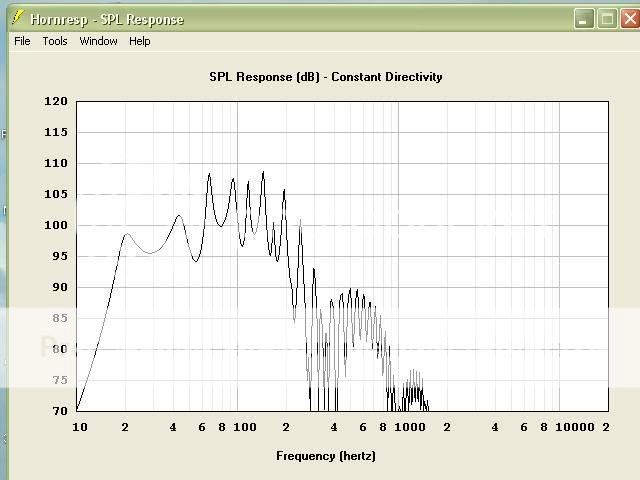
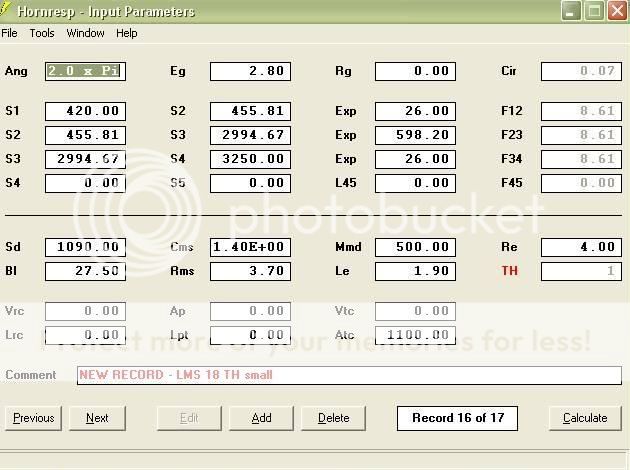
HornsKeith said:
As GM noted, the conventional wisdom on TH's puts you in some very large, low frequency tapped horns with those drivers due to their low Fs values (beginning iterations with 1/4 WL = Fs/1.6 to Fs/1.2). Compare that with the Danley TH-50, which is in the 20's with the MTX driver and already showed some significant in-room oscillations in the 80 - 100 Hz range according to the measurements from your GTG. It seems like you'd be looking at a very low c/o to make it work, though I'm sure the output in the 15 - 40 Hz range would be tremendous.
Keith
I figured as much. I'd be happy If I could get a relative useful range up to 60-80hz. I don't know if it's possible when getting extension down in the 20hz range or lower. I'm basically looking for the tremendous low end you mentioned.
I'm still kicking myself over the GTG and things I should've done. Why I didn't get a close mic in the horn mouth of the TH50 and THspud I just can't reconcile. It would've taken all of 1min and I just plain old didn't think of it until the next day. The responses that were posted/ taken were 3 foot away with the mic on the floor so there is quite a bit of room influence. What I do have is numerous close mics of the sealed LMS and XXX drivers and their responses measured the same way in the same room as the TH's, so I can do a bit of extrapolation there.
HornsKeith said:
It seems like you'd be looking at a very low c/o to make it work......
Hmm, if you mean due to the room modes, then it will be no different than with sealed, BR, etc.. The TH once damped should have a usable BW out to around 160-200 Hz if the specs are reasonably accurate, so enough for a fairly high XO point, though I personally wouldn't go > 70-80 Hz or whatever the floor/ceiling notch is.
GM
Josh Ricci said:
What are the parameters on that?
Specs:
Attachments
- Home
- Loudspeakers
- Subwoofers
- Collaborative Tapped horn project
